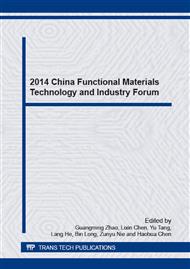[1]
F. Wypych, W. H. Schreiner and E. Richard. Journal of Colloid and Interface Science, Vol. 276 (2004) No. 1, p.167.
Google Scholar
[2]
K. Anastasiadou, D. Axiotis and E. Gidarakos. Journal of Hazardous Materials, Vol. 179 (2010) No. 1-3, p.926.
Google Scholar
[3]
K. Yanagisawa, et al. Journal of Hazardous Materials, Vol. 163. (2009) No. 2-3, p.593.
Google Scholar
[4]
E. Foresti, et al. Analytical and Bioanalytical Chemistry, Vol. 376. (2003) No. 5, p.653.
Google Scholar
[5]
X.R. Wang, et al. Lung Cancer, Vol. 75. (2012) No. 2, p.151.
Google Scholar
[6]
E. Gazzano, et al. Toxicology and Applied Pharmacology, Vol. 206. (2005) No. 3, p.356.
Google Scholar
[7]
K. Sakai, et al. Annals of Occupational Hygiene, Vol. 58. (2014) No. 1, p.103.
Google Scholar
[8]
P. C. Song, et al. Acta petrologica et mineralogica, Vol. 32 (2013) No. 06, p.905.
Google Scholar
[9]
A.F. Gualtieri, M.L. Gualtieri and M. Tonelli. Journal of Hazardous Materials, Vol. 156 (2008) No. 1-3, p.260.
Google Scholar
[10]
F. Wypych, et al. Journal of Colloid and Interface Science, Vol. 283 (2005) No. 1, p.107.
Google Scholar
[11]
K. Liu, et al. Journal of Non-Crystalline Solids, Vol. 353 (2007) No. (16-17), p.1534.
Google Scholar
[12]
L. Wang, et al. Journal of Colloid and Interface Science, Vol. 295 (2006) No. 2, p.436.
Google Scholar
[13]
L. Wang, et al. Applied Surface Science, Vol. 255 (2009) No. 17, p.7542.
Google Scholar
[14]
W.L. Rui L.A. Acta geologica ainica, Vol. 80 (2006) No. 2, p.180.
Google Scholar
[15]
K. Okada, et al. Microporous and Mesoporous Materials, Vol. 21 (1998) No. (4-6), p.289.
Google Scholar
[16]
J. Temuujin, K. Okada and K.J.D. MacKenzie. Applied Clay Science, Vol. 22 (2003) No. 4, p.187.
Google Scholar
[17]
R. Kusiorowski, et al. Journal of Thermal Analysis and Calorimetry, Vol. 109(2012) No. 2, p.693.
Google Scholar
[18]
G. Anbalagan, et al. Applied Clay Science, Vol. 42 (2008) No. (1-2), p.175.
Google Scholar
[19]
M.A. Saada, et al. Microporous and Mesoporous Materials, Vol. 122 (2009) No. (1-3), p.275.
Google Scholar
[20]
M. Rozalen, and F.J. Huertas. Chemical Geology, Vol. 352 (2013), p.134.
Google Scholar
[21]
M. Sprynskyy, J. NiedojadŁo and B. Buszewski. Journal of Physics and Chemistry of Solids, Vol. 72 (2011) No. 9, p.1015.
Google Scholar
[22]
T. Zaremba, et al. Journal of Thermal Analysis and Calorimetry, Vol. 101 (2010) No. 2, p.479.
Google Scholar


